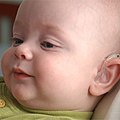Aural rehabilitation
Aural Rehabilitation is a process that facilitates a person with hearing loss to achieve optimal communication and participation in society. This process involves various therapeutic activities and counseling aimed at minimizing the impact of hearing loss on the individual's life.
Definition[edit]
Aural rehabilitation is a multifaceted approach to managing hearing loss that includes not only the use of hearing aids or cochlear implants, but also communication strategies, auditory training, speech-reading, and psychosocial support. The goal of aural rehabilitation is to optimize the individual's ability to participate in activities that are affected by hearing loss.
History[edit]
The concept of aural rehabilitation has evolved over time. Initially, it was primarily focused on children with hearing loss and included auditory training, speech reading, and language instruction. Over time, the focus has expanded to include adults with acquired hearing loss and a broader range of interventions.
Components[edit]
Aural rehabilitation consists of several components:
- Assessment: This involves a comprehensive evaluation of the individual's hearing loss, communication needs, and personal preferences.
- Hearing Aid Fitting: This includes the selection, fitting, and fine-tuning of hearing aids or cochlear implants.
- Auditory Training: This involves training the brain to make the best use of residual hearing and the sounds amplified by hearing aids or cochlear implants.
- Communication Strategies: This includes teaching strategies to improve communication, such as using context clues, asking for clarification, and managing background noise.
- Counseling and Psychosocial Support: This involves helping the individual and their family cope with the emotional and social impacts of hearing loss.
Benefits[edit]
The benefits of aural rehabilitation are numerous. It can improve communication, reduce feelings of isolation, and enhance quality of life. It can also help individuals with hearing loss to better understand their condition and make informed decisions about their care.
See Also[edit]
Ad. Transform your life with W8MD's Budget GLP-1 injections from $75


W8MD offers a medical weight loss program to lose weight in Philadelphia. Our physician-supervised medical weight loss provides:
- Weight loss injections in NYC (generic and brand names):
- Zepbound / Mounjaro, Wegovy / Ozempic, Saxenda
- Most insurances accepted or discounted self-pay rates. We will obtain insurance prior authorizations if needed.
- Generic GLP1 weight loss injections from $75 for the starting dose.
- Also offer prescription weight loss medications including Phentermine, Qsymia, Diethylpropion, Contrave etc.
NYC weight loss doctor appointmentsNYC weight loss doctor appointments
Start your NYC weight loss journey today at our NYC medical weight loss and Philadelphia medical weight loss clinics.
- Call 718-946-5500 to lose weight in NYC or for medical weight loss in Philadelphia 215-676-2334.
- Tags:NYC medical weight loss, Philadelphia lose weight Zepbound NYC, Budget GLP1 weight loss injections, Wegovy Philadelphia, Wegovy NYC, Philadelphia medical weight loss, Brookly weight loss and Wegovy NYC
|
WikiMD's Wellness Encyclopedia |
| Let Food Be Thy Medicine Medicine Thy Food - Hippocrates |
Medical Disclaimer: WikiMD is not a substitute for professional medical advice. The information on WikiMD is provided as an information resource only, may be incorrect, outdated or misleading, and is not to be used or relied on for any diagnostic or treatment purposes. Please consult your health care provider before making any healthcare decisions or for guidance about a specific medical condition. WikiMD expressly disclaims responsibility, and shall have no liability, for any damages, loss, injury, or liability whatsoever suffered as a result of your reliance on the information contained in this site. By visiting this site you agree to the foregoing terms and conditions, which may from time to time be changed or supplemented by WikiMD. If you do not agree to the foregoing terms and conditions, you should not enter or use this site. See full disclaimer.
Credits:Most images are courtesy of Wikimedia commons, and templates, categories Wikipedia, licensed under CC BY SA or similar.
Translate this page: - East Asian
中文,
日本,
한국어,
South Asian
हिन्दी,
தமிழ்,
తెలుగు,
Urdu,
ಕನ್ನಡ,
Southeast Asian
Indonesian,
Vietnamese,
Thai,
မြန်မာဘာသာ,
বাংলা
European
español,
Deutsch,
français,
Greek,
português do Brasil,
polski,
română,
русский,
Nederlands,
norsk,
svenska,
suomi,
Italian
Middle Eastern & African
عربى,
Turkish,
Persian,
Hebrew,
Afrikaans,
isiZulu,
Kiswahili,
Other
Bulgarian,
Hungarian,
Czech,
Swedish,
മലയാളം,
मराठी,
ਪੰਜਾਬੀ,
ગુજરાતી,
Portuguese,
Ukrainian

